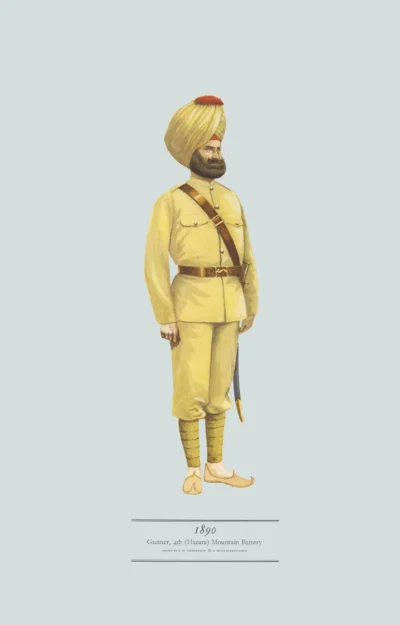1890 Gunner, 4th (Hazara) Mountain Battery
£12.50
1890 Gunner, 4th (Hazara) Mountain Battery (scroll down for a more detailed Description)
Published 1966 by © Hugh Evelyn Limited; drawn by Colonel Philip Henry Smitherman (1910-1982), Royal Corps of Signals
Size: c. 24.5 x 37.5cm [9 ½ ″ x 14 ½ ″] (may vary slightly from printers’ cut 50 years ago)
Printed on on medium cardstock weighing 144 g/sm2 faced in light greyish blue (RGB c. d5dede)
Print is STANDARD size – shipping is the same for 1 to 10 prints (based on largest print size in your order) – see Shipping & Returns
In stock
Description
In 1849 the Punjab was annexed. To maintain order the Punjab Irregular Frontier Force – the ‘Piffers’ was formed. It included 4 field batteries and 2 mountain batteries. After many attempts to use artillery in wild hill country a solution was found in the pack-gun, carried on a mule. When the Indian artillery transferred to the R.A. after the Mutiny the ‘Piffers’ did not. 2 field batteries were disbanded, 2 converted to mountain artillery. In 1860 2 Bombay field batteries became mountain batteries, and four more were raised. The mountain artillery was employed on the NW Frontier and became a separate branch of the Royal Artillery. Here is a Sikh gunner of the 4th (Hazara) Mountain Battery, formed in 1848. Sikhs were always good gunners, as the British found during the Sikh Wars, when many Sikh batteries served their guns to the last man. The mountain batteries wisely enlisted many Sikhs. Anyone who served the NW Frontier remembers with affection these big men with their little guns. Like all mountain batteries, the 4th (Hazara) was almost continuously in action through its history. One action was the 540-mile march in 1891 from Bannu across the Himalayas at 11,500 and 13,000 feet, to Hunza Nagar, fighting on the way. In 1939 it moved to Singapore and was captured when Singapore fell. The ‘Piffers’ were raised in khaki. Many never wore anything else. Sources: Photographs and items in the R.A. Museum.
Additional information
| Weight | 0.0125 kg |
|---|---|
| Dimensions | 24 × 37 cm |





